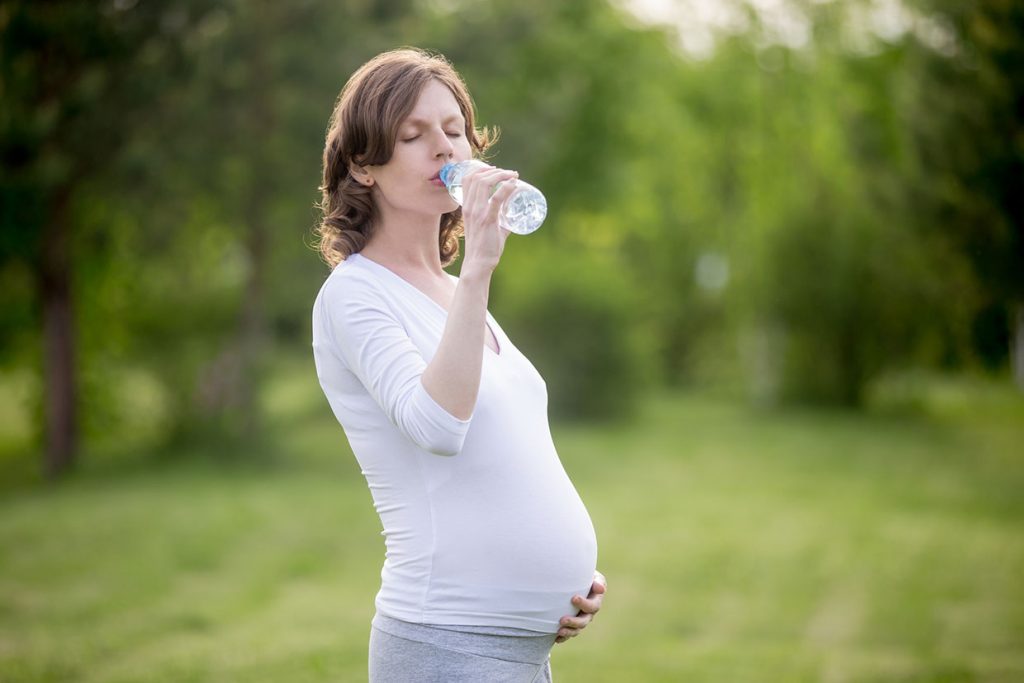Water does not typically enter the uterus, as it is protected by the cervix. However, if water enters the vagina, it can lead to an overgrowth of bacteria, which can cause infections such as yeast infections or bacterial vaginosis.
In some cases, douching can push these bacteria up into the uterus, fallopian tubes, and ovaries, resulting in further complications. It is important to maintain proper hygiene and avoid introducing water or other substances into the vagina to prevent these issues.
If you experience any symptoms or concerns, it is best to consult with a healthcare provider for proper diagnosis and treatment.

Credit: www.nct.org.uk
The Anatomy Of The Uterus
Water does not typically get inside the uterus when you swim or take a bath. However, if water enters your vagina, it can potentially cause infections or push bacteria up into the uterus, fallopian tubes, and ovaries. It is important to practice good hygiene to prevent these risks.
The uterus, also known as the womb, is a vital organ in the female reproductive system. It plays a crucial role in menstruation, pregnancy, and childbirth. Understanding the anatomy of the uterus is important to comprehend the potential effects of water getting into it.
Let’s explore the different parts of the uterus and their functions:
Overview Of The Uterus And Its Functions
- The uterus is a pear-shaped organ located in the pelvis, between the bladder and the rectum.
- Its main function is to support the development of a fertilized egg during pregnancy.
- During menstruation, the uterus sheds its lining, resulting in the monthly flow of menstrual blood.
- The uterus is responsible for contractions during labor, pushing the baby out through the cervix and into the birth canal.
Description Of The Different Parts Of The Uterus
- Fundus: The top part of the uterus, it is the rounded portion that lies above the entrance of the fallopian tubes.
- Body: The main part of the uterus, it is where the fertilized egg implants and grows during pregnancy.
- Cervix: The narrow lower portion of the uterus that connects to the vagina. It acts as a barrier between the uterus and the outside world.
- Uterine Wall: Composed of three layers – the innermost lining called the endometrium, the middle layer called the myometrium (made of smooth muscle), and the outermost layer called the perimetrium.
- Fallopian Tubes: Two thin tubes that extend from the upper corners of the uterus and are responsible for transporting the egg from the ovary to the uterus.
Understanding the anatomy of the uterus helps us to comprehend how water getting inside may affect its functions and overall reproductive health. It is essential to maintain proper hygiene practices and consult a healthcare professional if any concerns arise related to water entering the uterus.
Water And Vaginal Health
When water gets in your uterus, it can cause an overgrowth of harmful bacteria and increase the risk of infections like yeast infection or bacterial vaginosis. It can also push the bacteria causing the infection up into the uterus, fallopian tubes, and ovaries.
Therefore, it is crucial to avoid introducing water into the vagina.
The Relationship Between
- Water plays a crucial role in maintaining overall vaginal health. It helps to keep the vagina clean and hydrated, which is essential for preventing dryness and discomfort.
- Proper hydration is important for the body’s overall function, including vaginal health. Drinking an adequate amount of water helps to flush out toxins and maintain optimal vaginal pH levels.
- Water can also help to prevent urinary tract infections (UTIs), as it helps to dilute urine and flush out harmful bacteria that can cause infection.
The Risks And Dangers Of Introducing Water Into The Vagina
- While water is generally safe for vaginal health, there are certain risks and dangers associated with introducing water into the vagina, especially if done improperly.
- Using water as a form of vaginal hygiene, such as douching, can disrupt the natural balance of bacteria in the vagina and increase the risk of infections like bacterial vaginosis and yeast infections.
- Introducing water into the vagina during sexual activities, such as using water-based lubricants or engaging in water play, can also increase the risk of infections if proper hygiene practices are not followed.
- It’s important to avoid using direct water pressure, such as from a jet spray or strong water stream, as it can cause trauma to the delicate tissues of the vagina and lead to irritation or injury.
While water is generally safe for vaginal health, it’s important to maintain proper hygiene practices and avoid introducing water into the vagina in ways that can disrupt its natural balance. If you have concerns about your vaginal health or are experiencing any symptoms, it’s best to consult with a healthcare professional for proper diagnosis and treatment.
Remember, keeping your vagina clean and healthy is essential for overall well-being.
Pregnancy And Water In The Uterus
If water gets in your uterus, it can potentially lead to infections such as yeast or bacterial vaginosis. It is important to avoid douching as it can push the bacteria causing the infection further up into the uterus. Additionally, post-bath incontinence may occur due to pelvic floor laxity.
How Water Entering The Uterus Can Affect Pregnancy:
Water entering the uterus during pregnancy can have potential complications and risks for both the mother and the fetus. Here are some key points to consider:
- Increased risk of infection: When water enters the uterus, it can introduce bacteria or other harmful pathogens, increasing the risk of infection. This can lead to complications such as uterine or placental infections, which can be dangerous for both the mother and the baby.
- Premature rupture of membranes: Water in the uterus can sometimes cause the amniotic sac to rupture prematurely. This can result in preterm labor and delivery, which can pose risks to the baby’s health and development.
- Increased risk of complications during labor: If the water entering the uterus happens closer to the due date, it can interfere with the natural progression of labor. This can lead to complications such as a prolonged labor, increased pain, and the need for medical interventions like cesarean section.
Potential Complications And Risks For Both The Mother And The Fetus:
When water enters the uterus during pregnancy, it carries potential complications and risks that can impact both the mother and the fetus. Here are some important points to be aware of:
- Infection: Water entering the uterus can introduce bacteria or other pathogens, increasing the risk of infection. This can lead to conditions like chorioamnionitis (infection of the amniotic sac) or endometritis (infection of the uterine lining). These infections can have serious consequences for both the mother and the baby, including preterm labor, fetal distress, and maternal sepsis.
- Preterm labor: Water in the uterus can cause the premature rupture of membranes, leading to preterm labor and delivery. Babies born prematurely may face complications such as respiratory distress, developmental delays, and an increased risk of infections.
- Cord prolapse: In some cases, water entering the uterus can lead to cord prolapse, where the umbilical cord slips through the cervix before the baby, causing compression and potentially cutting off the baby’s oxygen supply. This is a medical emergency that requires immediate intervention to prevent harm to the baby.
- Fetal distress: Water entering the uterus can cause changes in the baby’s environment, potentially leading to fetal distress. This is characterized by abnormalities in the baby’s heart rate, indicating that the baby is not receiving enough oxygen and nutrients. Prompt medical intervention is necessary to ensure the well-being of the baby.
Remember, it is important to consult with a healthcare provider if you have concerns about water entering your uterus during pregnancy. They can provide personalized guidance and address any specific risks or complications based on your individual situation.
Water And Menstruation
Water entering the uterus can lead to potential health risks such as infections or complications during pregnancy. It is important to avoid introducing water into the vagina to prevent these issues.
The Impact Of Water On Menstruation:
Water is a natural element that plays a significant role in our daily lives. But have you ever wondered about the impact of water on menstruation? Let’s delve into the relationship between water and menstruation, and explore whether water in the uterus can affect menstrual flow and timing.
Can Water In The Uterus Affect Menstrual Flow And Timing?
Water in the uterus refers to the presence of water or liquid inside the uterine cavity. While it is unlikely for water to enter the uterus naturally, certain activities like swimming or douching might introduce water into the vagina, which could potentially reach the uterus.
So, what happens then? Here are a few key points to consider:
- Limited research: Unfortunately, there is a scarcity of scientific studies specifically addressing the impact of water in the uterus on menstrual flow and timing. Consequently, the information available on this topic is relatively limited.
- No direct evidence: As of now, there is no direct evidence suggesting that the presence of water in the uterus directly affects menstrual flow or timing. Menstrual flow is primarily governed by hormonal fluctuations and the shedding of the uterine lining, rather than external factors like water.
- Potential risks: While water in the uterus may not directly influence menstrual flow, it is essential to be mindful of potential risks associated with activities like swimming or douching. These practices can introduce bacteria into the vagina, leading to infections such as yeast infections or bacterial vaginosis. These infections may affect the overall vaginal health and potentially disrupt the regularity of menstrual cycles.
- Seek medical advice: If you have concerns about the impact of water in the uterus on your menstrual cycle, it is always recommended to consult with a healthcare professional. They can provide personalized guidance and address any specific concerns you may have.
Remember, maintaining good menstrual hygiene practices and avoiding excessive exposure to water in the vagina can help minimize potential risks.
Prevention And Treatment Of Water In The Uterus
If water gets in your uterus, it can cause bacterial infections, such as yeast infections or bacterial vaginosis. It can also lead to complications like pelvic floor laxity or post-bath incontinence. It is important to avoid getting excessive amounts of water in the vagina to prevent these issues.
When it comes to water getting into the uterus, prevention is key. Taking certain steps can help minimize the risk of water entering the uterus during activities like swimming or bathing. Additionally, if water does enter the uterus, prompt treatment can help prevent any potential complications.
Here are the steps to prevent water from entering the uterus:
- Empty your bladder before swimming or taking a bath: Before engaging in any water-related activities, make sure to empty your bladder. This can help reduce the chances of water getting pushed into the uterus.
- Use tampons or menstrual cups during swimming: If you have your period and plan to swim, using tampons or menstrual cups can create a barrier and prevent water from entering your uterus.
- Avoid diving into deep water: When engaging in activities like diving, be cautious and avoid diving into deep water. The force from diving can potentially push water into the uterus.
- Use a menstrual disc: Menstrual discs, like menstrual cups, can create a seal and help prevent water from entering the uterus during swimming or bathing.
In case water does enter the uterus, there are possible treatment options available. Here are some possible treatment options if water does enter the uterus:
- Drainage by a healthcare professional: If a large amount of water gets inside the uterus or if there are any symptoms of discomfort or infection, it is advisable to seek medical attention. Healthcare professionals can safely drain the water to prevent any complications or infections.
- Antibiotics: If water entering the uterus has caused an infection, such as bacterial vaginosis or a uterine infection, antibiotics may be prescribed to treat the infection.
- Pelvic examination: In some cases, a pelvic examination may be necessary to assess any potential damage or complications from water entering the uterus. This examination can help determine the appropriate course of treatment.
Remember, it is important to consult a healthcare professional for proper diagnosis and treatment if you suspect that water has entered your uterus. Prompt treatment can help prevent any potential complications and ensure your reproductive health.
Frequently Asked Questions Of What Happens If Water Gets In Your Uterus
Can Water Get In Your Uterus When You Swim?
Water does not enter your uterus when you swim, regardless of whether you have your period or not.
What Happens If You Put Water In Your Vag?
Putting water in your vagina can lead to an overgrowth of harmful bacteria, causing infections like yeast infection or bacterial vaginosis.
Why Do I Leak After A Bath?
Leaking after a bath can happen due to pelvic floor laxity or changes in bathing positions. It is important to manage post-bath incontinence and maintain good hygiene to avoid infections.
Faq 1: Can Water Get Inside Your Uterus When You Swim?
No, water doesn’t get inside your uterus when you swim, regardless of whether you have your period or not.
Faq 2: What Happens If You Put Water In Your Vagina?
Douching can cause an overgrowth of harmful bacteria, leading to yeast infections or bacterial vaginosis. It can also push bacteria causing infections up into the uterus, fallopian tubes, and ovaries.
Conclusion
Water entering the uterus can have various effects on a woman’s reproductive health. Putting water directly into the vagina, such as through douching, can disrupt the natural balance of bacteria and increase the risk of infections like yeast infections or bacterial vaginosis.
If a woman already has a vaginal infection, douching can push the bacteria further up into the uterus, fallopian tubes, and ovaries, potentially causing more serious complications. In addition, in rare cases, water breaking from the amniotic sac during pregnancy can lead to conditions like amniotic fluid embolism, which can be life-threatening for both the mother and baby.
It is important to take proper precautions when it comes to water and the uterus, avoiding unnecessary practices such as douching and consulting with healthcare providers if any concerns arise. By prioritizing vaginal health, women can maintain a healthy reproductive system and overall well-being.

